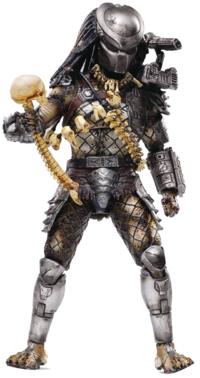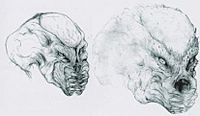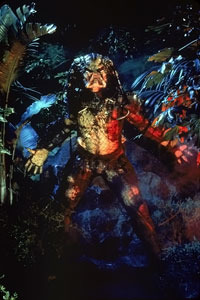Predator (fictional species) facts for kids
Quick facts for kids Predator |
|
|---|---|
| Predator race | |

A Predator, based on the one from the first film.
|
|
| Also known as | Yautja |
| First appearance | Predator (1987) |
| Created by |
|
| Information | |
| Home world | Yautja Prime |
| Type | Tribal extraterrestrial |
The Predator, also known as Yautja (pronounced), is the titular extraterrestrial species featured in the Predator science fiction franchise, characterized by its trophy hunting of other 'challenging' species for sport. First introduced in the film of the same name, the creatures returned in the sequels Predator 2 (1990), Predators (2010) and The Predator (2018) (the latter two of which introducing the rival clan of Hish-Qu-Ten), and the prequel Prey (2022), as well as the crossover films Alien vs. Predator (2004) and Aliens vs. Predator: Requiem (2007).
The Predator has been the subject of numerous novels, video games and comic books, both on their own and as part of the Alien vs. Predator crossover imprint. The species have been called Predators and Hunters in the movies, while Yautja, and Hish-qu-Ten have been alternatively used in the expanded universe. Created by brothers Jim and John Thomas, the Predators are depicted as large, sapient and sentient humanoid creatures who possess advanced technology, such as active camouflage, directed-energy weapons, and interstellar travel.
Concept and creation
Design

The Predator design is credited to special effects artist Stan Winston.
The Predator was originally designed with a long neck, a dog-like head, and a single eye. This design was abandoned when it became apparent that the jungle locations would make shooting the complex design too difficult. Originally, the studio contracted the makeup effects for the creature from Richard Edlund's Boss Film Creature Shop. However, problems filming the alien in Mexico led the makeup effects responsibilities to be given to Stan Winston. According to former Boss Films make-up supervisor Steve Johnson, the makeup failed because of an impractical design by McTiernan that included 12-inch leg extensions that gave the Predator a backward bent satyr-leg. The design did not work in jungle locations. After six weeks of shooting in the jungles of Palenque, Mexico, the production had to shut down so that Winston could make a new Predator. This took eight months and then filming resumed for five weeks, ending in February 1987.
Film portrayals

Jean-Claude Van Damme was originally cast as the Predator; the idea was that the star's abilities in martial arts would make the Predator an agile, ninja-esque hunter. With this first mantis-like costume, Van Damme had to walk on stilts because it had backward-bent reptilian legs and extended arms. But this was just too clumsy to handle on set; in the real jungle on muddy slopes of Mexico, it was virtually impossible to do physically.
When compared with Schwarzenegger, Carl Weathers, and Jesse Ventura, actors known for their bodybuilding regimens, it became apparent that a more physically imposing man was needed to make the creature appear threatening. Eventually, Van Damme was removed from the film and replaced by actor and mime artist Kevin Peter Hall. Hall played the Predator in the first and second movies. Having been trained in the art of mime, he used many tribal dance moves in his performance. The vocal effects of the Predator were provided by Peter Cullen, who made a clicking growl noise so he wouldn't strain his voice like he did in King Kong where he had to provide the uncredited vocal effects of the titular character.
Hall died not long after Predator 2 was released in theaters.
In Alien vs. Predator, Welsh actor Ian Whyte, standing at 7 feet 1 inch (2.16 m) and a fan of the Predator comics and movies, took over as the man in the Predator suits, including portraying the "Scar" Predator. Whyte returned to portray the "Wolf" Predator in Aliens vs. Predator: Requiem.
In Predators, actors Brian Steele and Carey Jones both portrayed a new breed of Predator known as the "Black Super Predators," who have been dropping humans on their planet for many years to play a survival game against them. In a nod to the first film, Derek Mears played the Predator as the creature appeared in the original, dubbed the "Classic Predator."
In The Predator, stuntman and parkour athlete Brian A. Prince, standing 6 feet 10 inches (2.08 m), portrays the title character, as a "standard" Predator that escapes to earth after stealing a weapon called "Predator Killer" and is being hunted down by a far larger genetically-enhanced Predator. The enhanced Predator is mostly CGI. However, 6-foot-9-inch (2.06 m) Canadian actor Kyle Strauts and Brian Prince served as stand-ins for the character on set.
In the prequel Prey, Dane DiLiegro performs the Predator. This Predator is a more primitive example of its species compared to the Predators featured in the original films, relying more on brute force and hand-to-hand combat when engaging its prey rather than the stealth-based attacks of its later kin. Its technology and weaponry similarly reflect this primitive approach.
Special and make-up effects
The Predator's blood was made from a combination of the liquid from glow sticks mixed with K-Y Jelly. The mixture loses its glow quickly, so new batches had to be quickly made between takes. The technique was used in all five films featuring the Predator.
The camouflage effect was designed by R/Greenberg Associates, under the direction of Joel Hynek. The idea for the effect came in a dream one of the Thomas brothers (who wrote the film) had, in which there was a chrome man who was inside a reflective sphere. The man blended in, perfectly camouflaged, reflecting from all directions and only visible when in motion. The effect was created by repeating an image in a pattern of ripples in the shape of the Predator's body. It proved very effective and was a new way of presenting an "invisible man". Before there was digital rendering technology, all of the camouflage was done optically using photo-chemical means, so that one would never get the same result twice from combining the same pieces of film.
After the original movies, Amalgamated Dynamics took over from Stan Winston Studio in creating the props for the Predators in the Alien vs. Predator film and a number of effects houses worked on the various other effects.
Characteristics
As the film series has progressed, the creature's design has been modified in many ways, including differences in skin color and pattern and variations in the design of the masks and armor.
Appearance
Predators are physically distinguished from humans by their greater height, arthropod-like mandibles and long, hair-like appendages on their heads that are set into their skulls (popularly perceived as "dreadlocks"). Their bodies are resilient to damage, capable of recovering from multiple gunshot wounds and radiation doses that would prove fatal to humans. Their wounds do, however, require medical attention and they incorporate a portable surgical kit in their armor for this purpose. They are also capable of enduring excruciating pain. Predators are much stronger than humans, easily capable of outmatching a conditioned adult human and shattering solid concrete with their bare hands. They are also skilled climbers and will readily move through trees or across rooftops in pursuit of prey. Though capable of surviving exposure in Antarctic temperatures for an extended period of time, it is implied that Predators have a preference for hot equatorial climates. Their blood is luminescent phosphor green in color. Their vision operates mainly in the infrared portion of the electromagnetic spectrum; they can easily detect heat differentials in their surroundings but are unable to easily distinguish among objects of the same relative temperature. A Predator bio-mask increases its ability to see in a variety of spectra, ranging from the low infrared to the high ultraviolet, and also filters the ambient heat from the area, allowing them to see things with greater clarity and detail. While they are capable of breathing Earth's atmosphere, the creature in Predator 2 is seen using a breathing mask after losing his helmet (although this Predator had just been shot multiple times and may have, therefore, not been operating at its full potential. A second possibility is that it was used to filter out impurities in the air— exhaust and such—which would not be found in more natural environments).
Throughout their film appearances, Predators have undergone numerous design variations. In Predator 2, the main Predator was designed to look more urban and hip than its predecessor. Design changes included tribal ornamentation on the forehead, which was made steeper and shallower, brighter skin coloration and a greater number of fangs. This Predator was made less reliant on its plasma caster, and more cunning with the use of nets, spears and bladed weaponry. In Alien vs. Predator, the appearance of the Predators was redesigned to make them seem more heroic. Redesigns included a reduction in head and waist size, broader shoulders, a more muscular physique, piranha-like teeth on the upper jaw, and dryer and less clammy skin to further differentiate them from the Aliens. In Aliens vs. Predator: Requiem, the Predator was returned to the sleeker design concept prior to Alien vs. Predator. For the so-called "Black Super Predators" in Predators, the designers used the differences between a cassette tape and an iPod as an analogy in differentiating the new Predators from the classic. The Super Predators were designed as leaner and taller than the "classic" Predator design, and they have longer faces, tighter armor, and more swept back dreadlocks.
Culture and history
The Predator society builds sophisticated spaceships, yet they should not look as sleek and hi-tech as a Star Wars stormtrooper. They are a tribal culture, yet their look should not be as primitive as the orcs from Lord of the Rings. They are also a warrior culture, so the ornate cannot conflict with the practical.
Predator culture revolves around the hunting and stalking of dangerous lifeforms. The reason Predators hunt is not for sustenance or elimination of threats, but as sportsmanship or rite of passage, as they will normally only attack life forms that have the ability to provide them with a challenge. In Predators, it is revealed that there are at least two different Predator tribes, which are engaged in a long-lasting blood feud.
Predators made contact with early human civilizations such as the Ancient Egyptians, the Khmer Empire, Aztecs, and the Comanche Nation, as well as a fictitious culture inhabiting what is now Bouvetøya. Upon arriving on Earth, the Predators were worshipped as gods by humans, and they taught many of the civilizations how to build pyramids (an explanation as to why many of these different ancient societies had distinctly similar cultures and architecture), but in return expected sacrifices of humans for use as hosts for huntable Xenomorphs (Aliens) — the ultimate prey for initiates. The Predators returned to Bouvetøya every century to consummate the bargain, until at one point in the ritual, the Xenomorphs spread out of control, resulting in the Predators detonating a bomb that obliterated the entire civilization. Relations between humans and Predators deteriorated from that time on; the Predators then viewed humans as little more than another quarry to hunt.
Predators feature prominently in the folklore of certain cultures; some Latin American people refer to the species as "El Diablo que hace trofeos de los hombres" (Spanish for "The Demon who makes trophies of men"), and Jamaican superstition identifies Predators as demons from the spirit world.
Language
The script of the Predators is expressed in the films and other media through written patterns of dashes. These written symbols appear on the creatures' gauntlet displays, their helmets, architecture, and many other surfaces. The most common vocalizations of the Predators consists of a series of clicks, roars, snarls, and growls which consist of recorded vocalizations of animals such as lions, tigers, leopards, jaguars, cougars, snow leopards, black bears, grizzly bears, dolphins, alligators, camels, and elephants. Predators will mimic human language on occasion, and have been shown to use their helmets to understand and speak human languages; some have also learned to speak human languages, even without the use of their helmets as well. Author Steve Perry designed a constructed language set for the Aliens vs. Predator novel series.
Film anthology
- Predator (1987)
- Predator 2 (1990)
- Alien vs. Predator (2004)
- Aliens vs. Predator: Requiem (2007)
- Predators (2010)
- The Predator (2018)
- Prey (2022)
See also
 In Spanish: Depredador (alienígena) para niños
In Spanish: Depredador (alienígena) para niños

